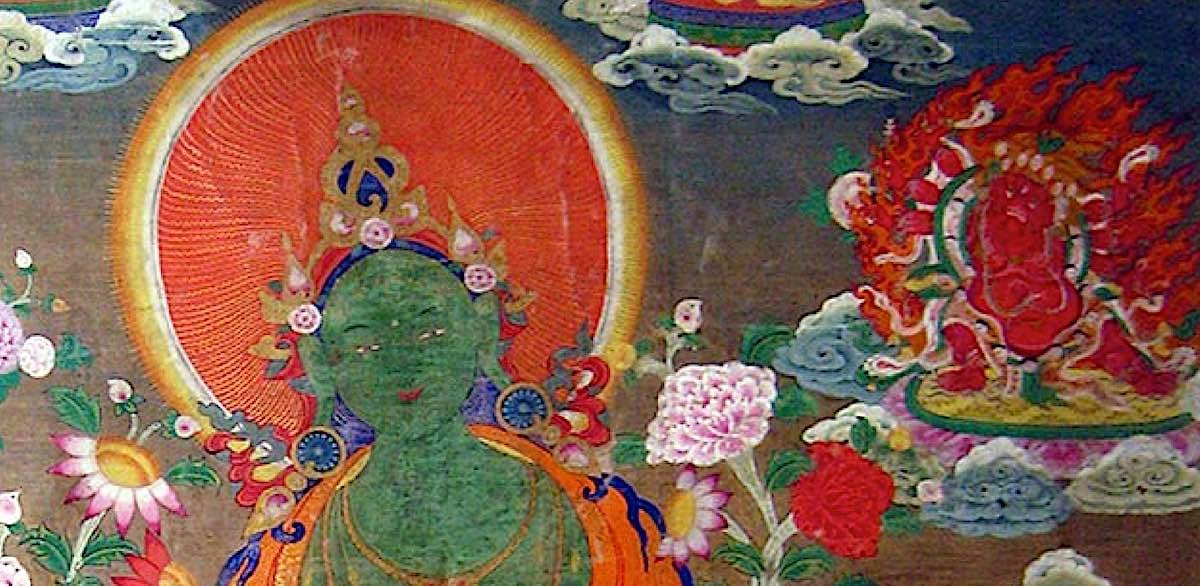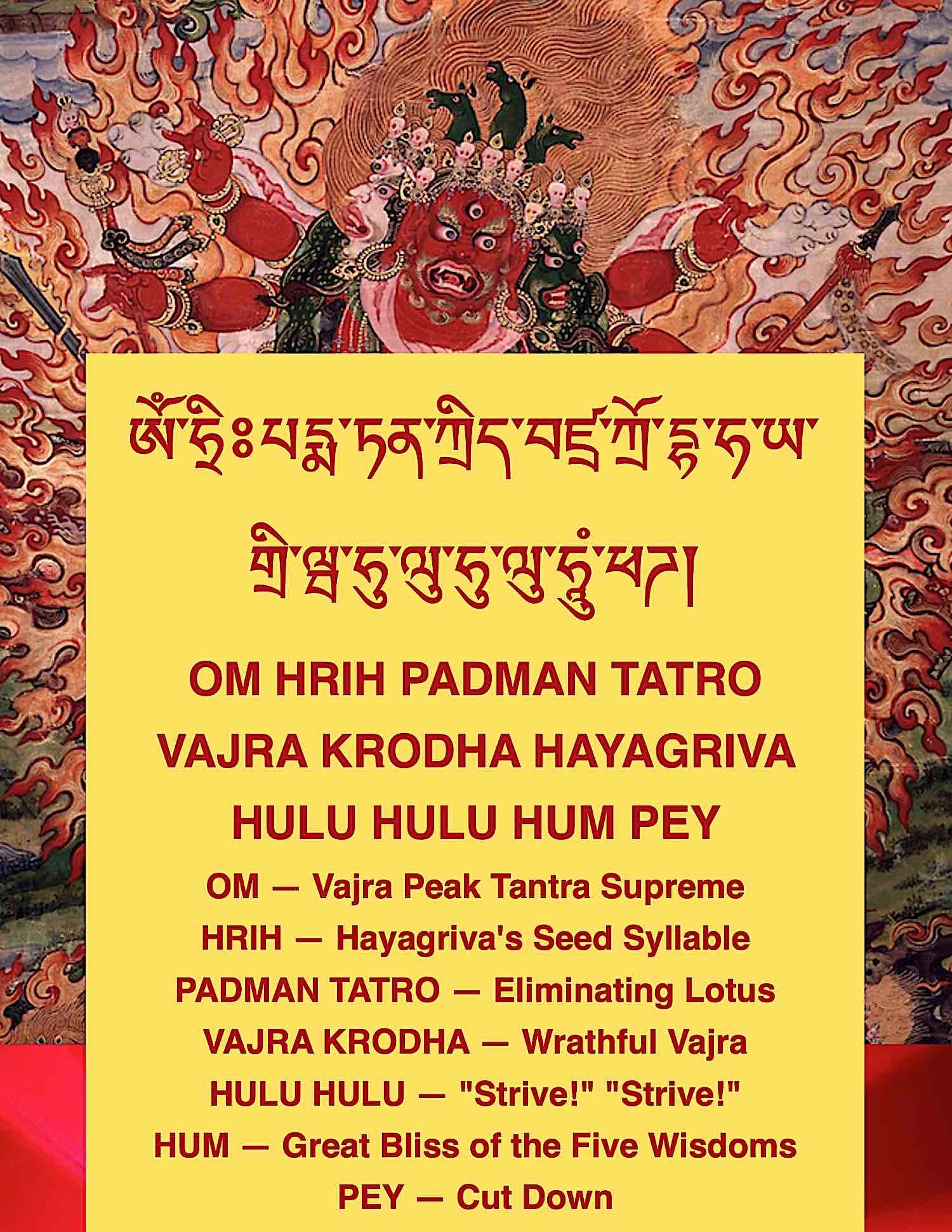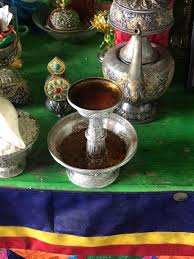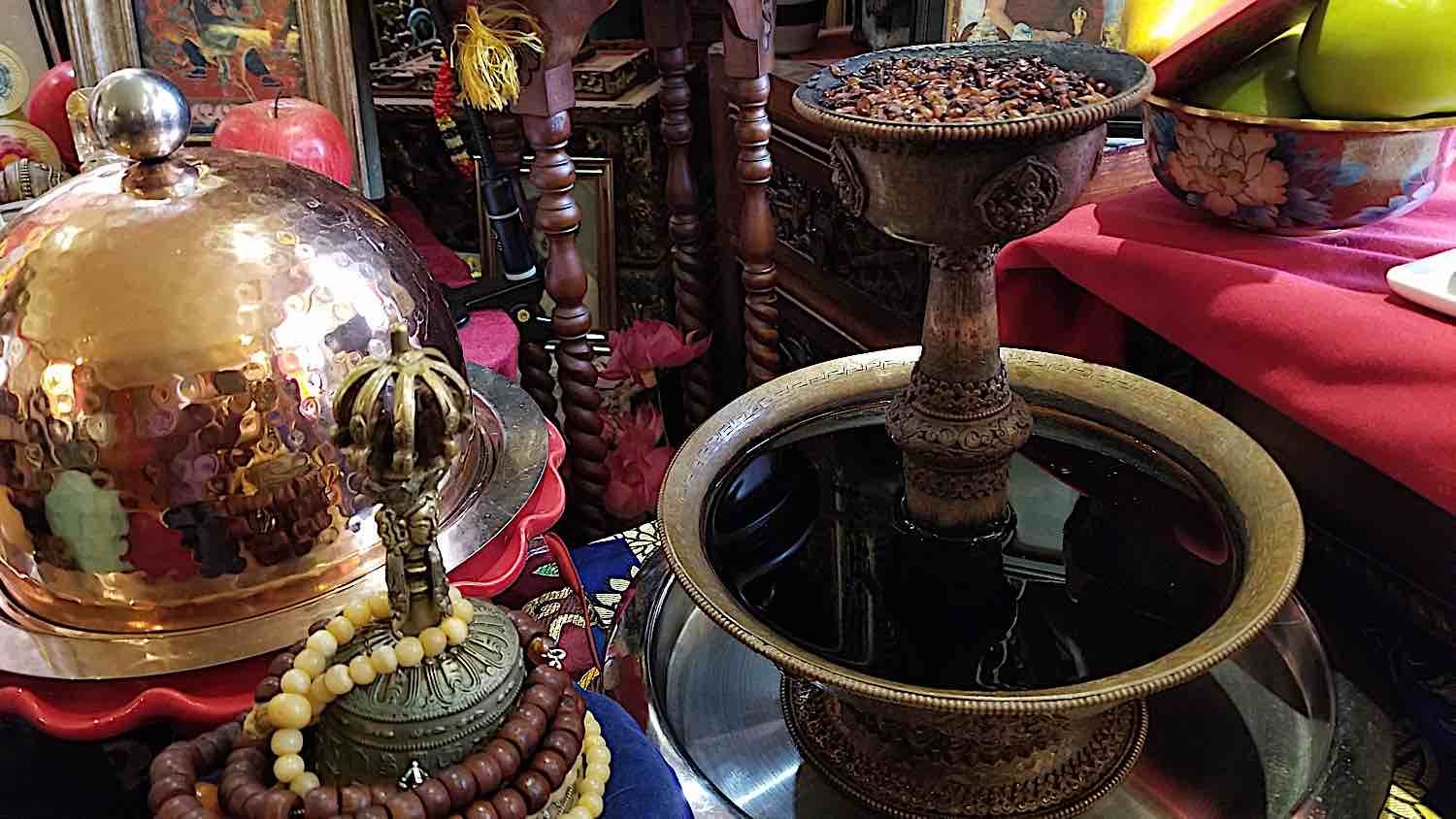Buddhist Practices for Pacifying War, including Hayagriva and Tara — the “pacifiers of war”
Hayagriva and Tara practices are only two of many practices in Tibetan Buddhism focused on averting war. Why are these two practices so effective in averting fear and strife of war — practices that endured centuries of human history...

Hayagriva and Tara practices are only two of many practices in Tibetan Buddhism focused on averting war.
Why are these two practices so effective in averting fear and strife of war — practices that endured centuries of human history marked by war?
If these practices work, why is there still war? [Quick answer: karma. More below.]
How can anyone benefit from their meditations and prayers? [Note, especially, the Prayer to Maitreya, Chenrezig, Hayagriva and Tara to Pacify War below.]

An early Tangkha featuring Tara and Hayagriva, who are two deities who can help “pacify” war, strife and fear.
Only 200 years of peace in history?
In history, it is difficult to find any period of prolonged peace and only two long periods of “relative peace.” The most publicized periods of “relative” peace were the Pax Romana — roughly 200 years of peace — and possibly the “relative peace” of the Cold War period 1945–1991 (depending on how you define war). Otherwise, the fear of war has always been with us. There is no doubt “war is out of date” as the Dalai Lama pointed out recently on his website:
“Our world has become so interdependent that violent conflict between two countries inevitably impacts the rest of the world. War is out-dated – non-violence is the only way. We need to develop a sense of the oneness of humanity by considering other human beings as brothers and sisters. This is how we will build a more peaceful world.”
Why is there war, despite our prayers? The answer, in Buddhist terms, is Karma. Karma leads to future consequences, karma-phala, “fruit of action.”

It seems, at times, that human history is a bloody tapestry of wars.
Buddhist Practices for Pacifying War
In Buddhism, there are many practices for pacifying war — starting as early as Buddha’s teachings on the Eightfold Path. Certainly, the causes of war are identified in the Four Noble Truths.
In the 14th century, the great yogin Tangtong Gyelpo wrote the “Prayer to Pacify War” to Hayagriva and Tara [Full prayer below!].
The 13th Tara (of the 21 Taras) is very focused on averting war and strife.
Hayagriva — the wrathful emanation of Amitbaha and Chenrezig — is all about pacifying war and suffering. Traditionally, his practices are still effective today, since his Mandala remains in our world. [See Hayagriva video below and linked feature.]
Green Tara, in general, is all about overcoming the eight fears, including war and violence.
21 Praises to Tara in English:
Deity Practices to Avert War
In Tibetan Buddhism, the main go-to superhero we go to in times of fear and war is Green Tara — and also the great Heruka aspect of Amitabha and Chenrezig known as Hayagriva. In Green Tara, many Tibetan Buddhists recite the 21 Praises to Tara twice a day (morning and evening). Notable in the 21 Taras as practices focused on suppressing or pacifying strife and war are the 13th Tara. Gesar of Ling, a heroic “king” in Tibetan legend also focuses extensively on overcoming fear and averting strife. (Gesar is virtually synonymous with overcoming fear.)
Yoko Dharma chants the mantra to the 13th Tara:
13th Tara Wrathful “Remover of Obstacles … Destroy All Enemies”
In Surya Gupta Lineage she is known as the Remover of Obstacles, and is red and wrathful. Her praise, in English is:
PRAISE TO TARA THE COMPLETE RIPENER
Homage to You, who dwell in garlands of flames
Engulfed in fire like the end of the aeon.
Right leg outstretched and left bent with blissful joy
Who with your power destroy all enemies.
MANTRA of 13th Tara (Surya Gupta lineage)
OM TARE TUTTARE TURE PHO TRA YA BHAY MEM KURU SOHA
NOTE: Destroying enemies means destroying hate, ignorance, and other obstacles to peace. The enemy is the poisons of hate, attachment, and all the poisons.
In the Atisha system of Taras, she is also specifically known as the “Tara who stops wars.”
Short video documentary on Hayagriva:
Resources
Entire feature section on Tara on Buddha Weekly (many features)>> In-Depth Feature on Hayagriva>> Feature on Fear and Gesar of Ling>> Praises to the 21 Taras>> 13th Tara on Youtube>> 21 Praises (in English) chanted on YouTube>> All about Tara Pujas >> Sutra teachings on Fear>> The power or prayer>>Karmaphala: If pacifying practices work, why is there war?
The obvious question — especially after enduring the Pandemic and now a war in the Ukraine region — is “If these practices work, why is there war?”
Merit practices and pacifying practices in Buddhism help us to overcome negative karma — and the results of this karma, which is suffering. Unfortunately, the collective negative karmas of all beings cannot be overcome by practices of this sort. They certainly help, in the same way individuals can help in any situation. We can apply our collective merit with Tara and Hayagriva practices, and other mertorious practices, but we are helping — not eliminating. Why, not eliminating it? Because the negative karmas of a human history of suffering is difficult to overcome with any merit practice.
If so, why bother? Because they do help. Prayers do help. We are setting the intention for peace. We are creating positive future Karma — so that the future outcome is peace. Ultimately, Buddha’s teachings that help us escape the cycle of Samsara strongly focus on creating positive karma — notably:
Right Understanding Right Intent Right Speech Right Action Right Livelihood Right Effort Right Mindfulness Right Concentration. For more on the Eightfold Path, see>>Video on the Eightfold Path:
Bodhisattva Way: Averting War
Venerable Thubten Chodron gives the Sravasti Abbey community in Winter Retreat an update and background about the Russian invasion of Ukraine that began on February 23, 2022. She encourages us to examine how we relate to power and the things we are attached to, which fuel our conflicts on the interpersonal level. She then reviews verses 3 and 4 of Shantideva’s “Engaging in a Bodhisattva’s Deeds.”:
In a journal feature titled Reducing Suffering During Conflict: The Interface Between Buddhism And International Humanitarian Law — commissioned due to a project launched by the International Committee of the Red Cross (ICRC) in 2017, the author wrote:
“Given that Buddhism is in origin a renouncer religion which discourages war and violence, it is often assumed that it has little to say about the conduct of hostilities once wars break out, and most humanitarian interventions in the Buddhist world have focused instead on how Buddhism can contribute to preventing or resolving armed conflict and coming to terms with its aftermath…” [3]
Tara’s Mantra is chanted by Buddhists around the world for protection. Chant along with the Amazing Yoko Dharma:
Green Tara — the Savior
Green Tara — or any of her 21, 108, 1008 forms — is called the “savior” and the rescuer. She is beloved around the world as the “Karma Buddha” form. Green is the color of Karma and activity. She is active in our world, at the same time a super-hero Bodhisattva and a fully Enlightened Buddha. Since her wisdom activity has assisted all of the Buddhas of all time, she is called the Mother of All the Buddhas.
She is nearest to us in this world, because she remains active. Regardless of what practice a yogi or yogini might personally undertake, in a moment of trouble, the first mantra on the lips will inevitably be Green Tara:
Om Tare Tuttare Ture Svaha
A Green Tara meditation guided by Venerable Zasep Rinpoche with mantra chanting:
Hayagriva and Samaya Tara
Separately, Hayagriva and Tara are both practices renowned for averting war or pacifying war and suffering. One Highest Yoga practice (requiring empowerment) combines the two, with Samaya Tara Dakini (a six-armed special form of Tara) and consort Hayagriva. You don’t have to seek out this special practice, however, as Tara and Hayagriva are accessible to all, and their mantras and praises — separately — are powerful and available to anyone.
Hayagriva — the great Pacifier
Shabkar indicated in this quote that Hayagriva’s “mandala have not yet vanished.” In other words, Hayagriva is very much accessible to practitioners today — not just the ancient masters.
In modern terms, Hayagriva is the “Incredible Hulk” emanation of Amitabha and Chenrezig and Vajravarahi — his wisdom consort — is the ultimate Dakini. (In some tantras, Green Tara is Hayagriva’s consort. Tara and Vajravarahi are, in essence, One.) Despite his wrathful form, he is still chief among the compassionate, important in modern times.
The mantra of Hayagriva — the Heruka of Speech — is most helpful in averting strife, war, and also for protection. The mantra is:
OM HRIH PADMAN TATRO VAJRA KRODHA HAYAGRIVA HULU HULU HUM PHAT.
In Tibetan, this is typically pronounced:
OM HRIH PEMA THAN DRIH BENZA TROHDHA HAYA GRI WA HOOLOO HOOLOO HUNG PHET!

The mantra of Hayagriva Sang Drup in Tibetan characters, English transliteration of Sanskrit (not Tibetan) and the concise explanation of the meaning of the mantra.
According to a teaching synopsis of H.E. Choden Rinpoche’s 2013 visit to the Kurukulla centre:
“Hayagriva is a wrathful manifestation of Chenrezig, the embodiment of all the Buddha’s compassion. Devotion to and practice based upon Hayagriva is a swift and powerful means to overcome negative forces and obstacles. Prayers to Hayagriva are especially beneficial in these degenerate times when sufferings and illnesses are rampant due to the strong delusions of sentient beings.
Prayer to Pacify War by Tangtong Gyelpo
The great yogin Tangtong Gyelpo famously wrote the “Prayer to Pacify War” to Hayagriva and Tara — the two meditational deities who have the function of suppressing or pacifying wars — in the 14th century. As translated by Sean Price:
ཅེས་པ་འདི་ཉིད་མདོ་ཁམས་མི་ཉག་གི་ཡུལ་དུ་གཡུལ་འཁྲུགས་རྒྱུན་མི་ཆད་པ་སུས་ཀྱང་འདུམ་པར་མ་ནུས་པའི་ཚེ། རྗེ་གྲུབ་ཐོབ་ཆེན་པོ་བྱོན་ཞོར་ཕྱོགས་དེར་ཕེབས་ནས་ཐུགས་བསྐྱེད་མཛད། བདེན་ཚིག་གསུངས་ཤིང་མེ་ཏོག་འཐོར་བ་ཙམ་གྱིས་ཐམས་ཅད་ཀྱི་ཕྲག་དོག་དང་ཞེ་སྡང་གི་གདུག་སེམས་ཐམས་ཅད་ཞི་ཞིང་གཡུལ་འཁྲུགས་རྒྱུན་ཆད། །ལོ་ལེགས་སྐྱ་རྒྱལ་སོགས་བཀྲ་ཤིས་ཕུན་སུམ་ཚོགས་པའི་རྡོ་རྗེའི་གསུང་བྱིན་རླབས་ཅན་ནོ།།
“When war raged in Minyak, Kham, and it looked as if there was no end in sight, for no one was able to pacify the warring factions, the great yogin Thangtong Gyalpo arrived. He generated bodhicitta, and by merely reciting these verses and scattering flowers, quelled the anger and jealousy in the minds of the warring factions so that the conflict came to an end. All came to have bountiful harvests and enjoy prosperity, auspiciousness and peace.” [1]
༄༅། །མཚོན་གྱི་འཇིགས་པ་ཞི་བའི་བདེན་ཚིག
Prayer of Truthful Words to Pacify the Fear of War
by Thangtong Gyalpo
ཨོཾ་མ་ཎི་པདྨེ་ཧཱུྃ།
om mani padmé hung
Oṃ maṇi padme hūṃ
བྱམས་ཆེན་རྒྱལ་བ་འཕགས་མཆོག་སྤྱན་རས་གཟིགས། །
jamchen gyalwa pakchok chenrezik
Victorious Maitreya, sublime and noble Avalokiteśvara,
ཁྲོ་རྒྱལ་རྟ་མགྲིན་རྗེ་བཙུན་སྒྲོལ་མ་སོགས། །
trogyal tamdrin jetsün drolma sok
Ferocious king Hayagrīva, Jetsün Tārā, and the rest –
མཚན་ཙམ་ཐོས་པས་འཇིགས་པ་ཀུན་སེལ་བའི། །
tsen tsam töpé jikpa kün selwé
Buddhas, the mere sound of whose names dispels all fear;
སྐྱབས་གནས་ཐུགས་རྗེའི་བདག་ཉིད་དགོངས་སུ་གསོལ། །
kyabné tukjé daknyi gong su sol
Compassionate sources of refuge, pray grant me heed.
རྩོད་ལྡན་སྙིགས་མ་ལྔ་བདོའི་སེམས་ཅན་རྣམས། །
tsöden nyikma nga dö semchen nam
In this time when individuals experience an oceanic surge
ལས་ངན་ཕྲག་དོག་མཚོ་ཆེན་བརྡོལ་བ་ལས། །
lé ngen trakdok tso chen dolwa lé
Of negative karma and jealousy – the age of fivefold decadence and strife –
འཐབ་རྩོད་སྡུག་བསྔལ་དྲག་པོས་མནར་བ་ན། །
tabtsö dukngal drakpö narwa na
As intense suffering, fighting and quarrelling oppress us,
ཡེ་ཤེས་ཐུགས་རྗེའི་ཞུགས་ཀྱིས་སྐེམས་པར་མཛོད། །
yeshe tukjé shyuk kyi kempar dzö
Pray burn it all in the fires of your compassionate wisdom.
ཞེ་སྡང་མེ་དཔུང་འབར་བའི་འགྲོ་བ་ལ། །
shyedang mepung barwé drowa la
Shower the nectar of love
བྱམས་པའི་བདུད་རྩིའི་ཆར་ཆེན་ཕབས་ནས་ཀྱང་། །
jampé dütsi char chen pab né kyang
Upon those who fan the flames of hatred.
ཕན་ཚུན་ཕ་མ་ལྟ་བུའི་འདུ་ཤེས་ཀྱིས། །
pentsün pama tabü dushé kyi
Bless them to recognize each another as parents,
བདེ་སྐྱིད་བཀྲ་ཤིས་འཕེལ་བར་བྱིན་གྱིས་རློབས། །
dekyi tashi pelwar jingyi lob
And thereby usher in auspiciousness and happiness.
གང་གི་རྒྱུད་ལ་ཞུགས་པའི་སྐད་ཅིག་གིས། །
gang gi gyü la shyukpé kechik gi
May the mischievous elemental spirits
བློ་སྣ་ལྷ་མིན་བཞིན་དུ་བསྒྱུར་བྱེད་པའི། །
lona lhamin shyindu gyur jepé
That enter the minds of beings
འབྱུང་པོ་གདུག་པའི་ཚོགས་རྣམས་ཚར་བཅད་ནས། །
jungpo dukpé tsok nam tsarché né
And instantaneously transform their hosts into warring titans,
ཕྱིན་ཆད་ཕྱོགས་འདིར་རྒྱུ་བར་མ་གྱུར་ཅིག །
chinché chok dir gyuwar magyur chik
Never hold sway in this region again.
གཡུལ་ངོར་ཤི་བའི་སེམས་ཅན་ཐམས་ཅད་ཀྱང་། །
yulngor shiwé semchen tamché kyang
May all who have died in battles, fighting and wars,
དེང་ནས་ལས་ངན་རྒྱུ་འབྲས་ཀུན་སྤངས་ནས། །
deng né lé ngen gyundré künpang né
Immediately give up their indulgence in destructive action, cause and effect,
བདེ་བ་ཅན་དུ་རྫུས་ཏེ་སྐྱེས་ནས་ཀྱང་། །
dewachen du dzü té kyé né kyang
And, having taken birth in the pure realm of Sukhāvatī,
ཐམས་ཅད་ཞིང་དེར་འཁྲིད་པར་མཛད་དུ་གསོལ། །
tamché shying der tripar dzé du sol
Lead all to that same buddha realm.
སྐྱེ་རྒུ་ཐམས་ཅད་ཚེ་རིང་ནད་མེད་ཅིང་། །
kyegu tamché tsering nemé ching
May all beings have long, healthy lives,
འཐབ་རྩོད་ཀུན་ཞི་དགེ་བ་བཅུ་ལ་སྤྱོད། །
tabtsö kün shyi gewa chu la chö
Be free of quarrels and strife, live according to the ten virtues,
ཆར་ཆུ་དུས་འབབ་ལོ་ཕྱུགས་རྟག་ཏུ་ལེགས། །
charchu dü bab lo chuk taktu lek
And experience timely rains and bountiful harvests;
སྣོད་བཅུད་བཀྲ་ཤིས་འཕེལ་བར་མཛད་དུ་གསོལ། །
nöchü tashi pelwar dzé du sol
And may the auspiciousness of the environment and beings increase exponentially.
ཆོས་ཉིད་རང་བཞིན་རྣམ་པར་དག་པ་དང་། །
chönyi rangshyin nampar dakpa dang
May these pure, vast prayers be accomplished
ཆོས་ཅན་རྒྱུ་འབྲས་བསླུ་བ་མེད་པ་དང་། །
chöchen gyundré luwa mepa dang
Through the compassion of the Guru, Yidam, and Three Rare and Sublime Ones;
བླ་མ་ཡི་དམ་དཀོན་མཆོག་ཐུགས་རྗེ་ཡིས། །
lama yidam könchok tukjé yi
Suchness, which by its very nature is utterly pure;
རྣམ་དག་སྨོན་ལམ་རྒྱ་ཆེན་འགྲུབ་པར་ཤོག །
namdak mönlam gyachen drubpar shok
And the appearance of things, the undeceiving nature of cause and effect.
ཅེས་པ་འདི་ཉིད་མདོ་ཁམས་མི་ཉག་གི་ཡུལ་དུ་གཡུལ་འཁྲུགས་རྒྱུན་མི་ཆད་པ་སུས་ཀྱང་འདུམ་པར་མ་ནུས་པའི་ཚེ། རྗེ་གྲུབ་ཐོབ་ཆེན་པོ་བྱོན་ཞོར་ཕྱོགས་དེར་ཕེབས་ནས་ཐུགས་བསྐྱེད་མཛད། བདེན་ཚིག་གསུངས་ཤིང་མེ་ཏོག་འཐོར་བ་ཙམ་གྱིས་ཐམས་ཅད་ཀྱི་ཕྲག་དོག་དང་ཞེ་སྡང་གི་གདུག་སེམས་ཐམས་ཅད་ཞི་ཞིང་གཡུལ་འཁྲུགས་རྒྱུན་ཆད། །ལོ་ལེགས་སྐྱ་རྒྱལ་སོགས་བཀྲ་ཤིས་ཕུན་སུམ་ཚོགས་པའི་རྡོ་རྗེའི་གསུང་བྱིན་རླབས་ཅན་ནོ།།
When war raged in Minyak, Kham, and it looked as if there was no end in sight, for no one was able to pacify the warring factions, the great yogin Thangtong Gyalpo arrived. He generated bodhicitta, and by merely reciting these verses and scattering flowers, quelled the anger and jealousy in the minds of the warring factions so that the conflict came to an end. All came to have bountiful harvests and enjoy prosperity, auspiciousness and peace.
| Translated by Sean Price, 2020. [2]
Source: “grub chen thang stong rgyal po’i rdo rje’i gsung mtshon gyi ‘jigs pa zhi ba’i bden tshig” in mkhyen brtse’i dbang po, blo gter dbang po. sgrub thabs kun btus. TBRC W23681. 14 vols. Kangra, H.P.: Indo-Tibetan Buddhist Literature Publisher, Dzongsar Inst. for Advanced Studies, null. http://tbrc.org/link?RID=W23681 Vol. 14: 658–659
Tea Offering to Hayagriva
Hot tea is offered with mantras and prayers to symbolize “activity” of wrathful Hayagriva. This short, auspicious tea offering and prayer can be offered daily. No empowerment is required. You can chant mantras as you pour tea at the end of each line, or just pour tea, such as: Om Ah Hum, or the mantra of Hayagriva.

Tea offering serkhem.
Traditionally, use a Serkhem. Otherwise, place a cup (ideally a stemmed cup to encourage a flow of tea) inside a larger bowl. You pour hot tea, signifying enlightened activities, allowing it to overflow the cup to signify auspicious blessings. Ideally, place blessed rice or grains (Om Ah Hum is a good blessing mantra) into the upper bowl as shown in the picture below. In some traditions, you use mixed colours of grain.
HRIH! Hayagriva, the nine gaited king, fierce and majestic,
You have come forth from the heart of Amitabha to defeat the evil designs of humans and non-human spirits.
I sing praises of you and your host of deities.
Who vanquish all foes of the Dharma and protect the practitioners;
I sing praises to you all.
HRIH! O fierce Vajra, born from the syllable HRIH
You, Hayagriva, cast your fierce gaze upon the troublemakers.
I prostrate to you who controls the three realms
Through the resounding voice of HULU HULU HUM PEY!
I pray that you partake of the ritual cakes and sacred offerings
Multiply your fourfold actions of peace, increase, power and wrath
Increasing the life, good health, merit, glory, and wealth,
Of myself and my retinue, and those your yogis, teachers, and disciples.

A large formal tea serkym offering set with grains and black tea offerings. The go-to practice for removing obstacles is the “Serkyem” tea offering to the Buddhas, the Bodhisattvas, and the Enlightened Protectors, who are the ferocious manifestations of the Buddhas.
NOTES
[1] Source: “grub chen thang stong rgyal po’i rdo rje’i gsung mtshon gyi ‘jigs pa zhi ba’i bden tshig” in mkhyen brtse’i dbang po, blo gter dbang po. sgrub thabs kun btus. TBRC W23681. 14 vols. Kangra, H.P.: Indo-Tibetan Buddhist Literature Publisher, Dzongsar Inst. for Advanced Studies, null. http://tbrc.org/link?RID=W23681 Vol. 14: 658–659
[2] Sean Price, Lotsawa House>>
[3] “Reducing Suffering During Conflict: The Interface Between Buddhism And International Humanitarian Law“ found here>>

 ShanonG
ShanonG 
































